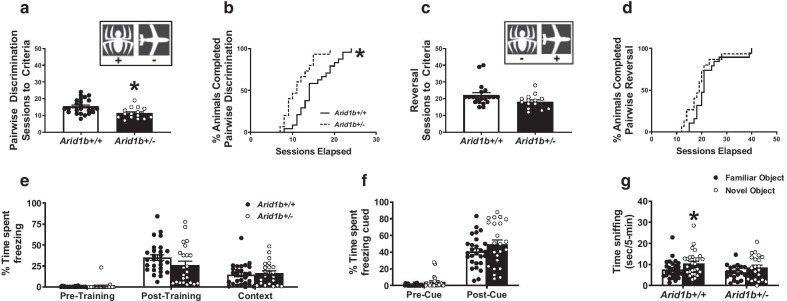Fig. 7.
Largely intact learning and memory in Arid1b+/−. To assess learning and memory and behavioral flexibility in a computerized automated task, that does not rely heavily on motor skills, we utilized a visual pairwise discrimination touchscreen task. Mice are food-restricted and trained to initiate and execute trials by touching their noses to the touchscreen. Mice are then trained to associate an image (a spider or an airplane, A inset) with a food reward. a Arid1b+/− required fewer sessions to reach criteria of 80% accuracy for two consecutive days compared to Arid1b+/+ littermates indicating no deficits in ability to acquire visual discrimination. b As a group, Arid1b+/− completed acquisition of the pairwise discrimination task faster than Arid1b+/+, with larger proportions of mice finishing sooner (survival curve). Once animals achieved task criteria, they underwent reversal of the task where the opposite image now becomes the correct image (C, inset). c and d Arid1b+/− showed no behavioral inflexibility or deficits in learning and memory in pairwise discrimination reversal compared to Arid1b+/+ by c no difference in number of sessions required to reach criteria (d) and no difference in proportion of mice reaching criteria of 75% accuracy for two consecutive days (survival curve, D). e and f In a canonical learning and memory tasks with less motor involvement, Pavlovian contextual and auditory cue fear conditioning, Arid1b+/+ and Arid1b+/− demonstrated normal associative learning and memory abilities. Learning and memory was assessed by percentage of time spent freezing after associating a context and tone cue with a 0.5 mA foot shock. e Arid1b+/− successfully acquired fear memory during training and showed intact contextual memory of their environment 24 h later. There was no difference in % freezing between Arid1b+/+ and Arid1b+/. f Arid1b+/− also showed intact cued learning of an auditory tone compared to Arid1b+/+. Recognition memory was tested using a novel object recognition test in an open area. Mice are habituated to an open field arena for 24 h, familiarized for 10 min to two identical objects equally spaced in the arena. After an hour long intertrial interval, one object is replaced with a novel one and mice are allowed to explore for 5 min. Time spent sniffing the objects is recorded. Mice exhibit novel object recognition when they spend more time investigating the novel object compared to the familiar object. g Arid1b+/+ successfully showed a preference for the novel object and spent more time sniffing the novel object whereas Arid1b+/− failed to show a preference and spent equal time sniffing both objects. For (a and b), Arid1b+/+ N = 24, Arid1b+/− N = 15, for (c and d), Arid1b+/+ N = 20, Arid1b+/− N = 14, for e and f, Arid1b+/+ N = 27, Arid1b+/− N = 23, for (g), Arid1b+/+ N = 27, Arid1b+/− N = 21. * p < .05 versus Arid1b+/+ by repeated measures Two-Way ANOVA or Student’s unpaired t test. Error bars represent mean ± SEM

